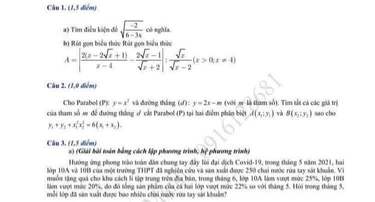
Hãy nhập câu hỏi của bạn vào đây, nếu là tài khoản VIP, bạn sẽ được ưu tiên trả lời.



Câu 1:
1) Ta có: \(2x^2+5x-3=0\)
\(\Leftrightarrow2x^2+6x-x-3=0\)
\(\Leftrightarrow\left(x+3\right)\left(2x-1\right)=0\)
\(\Leftrightarrow\left[{}\begin{matrix}x=-3\\x=\dfrac{1}{2}\end{matrix}\right.\)
2) Để hàm số đồng biến trên R thì m-1>0
hay m>1
Câu 1:
3) Ta có: P=a+b-2ab
\(=1+\sqrt{2}+1-\sqrt{2}-2\left(1+\sqrt{2}\right)\left(1-\sqrt{2}\right)\)
\(=2-2\cdot\left(-1\right)=4\)

câu 2 thì mk có pt nhưng mk ko bt giải
\(\left\{{}\begin{matrix}\dfrac{1}{x}-\dfrac{1}{y}=\dfrac{1}{10}\\x-y=15\end{matrix}\right.\)

a) Thay m=3 vào hệ pt, ta được:
\(\left\{{}\begin{matrix}x+3y=3\\3x+4y=6\end{matrix}\right.\Leftrightarrow\left\{{}\begin{matrix}3x+9y=9\\3x+4y=6\end{matrix}\right.\)
\(\Leftrightarrow\left\{{}\begin{matrix}5y=3\\x+3y=3\end{matrix}\right.\Leftrightarrow\left\{{}\begin{matrix}y=\dfrac{3}{5}\\x=3-3y=3-3\cdot\dfrac{3}{5}=\dfrac{6}{5}\end{matrix}\right.\)
Vậy: Khi m=3 thì hệ phương trình có nghiệm duy nhất là \(\left(x,y\right)=\left(\dfrac{6}{5};\dfrac{3}{5}\right)\)


a) Thay m=3 vào hệ phương trình, ta được:
\(\left\{{}\begin{matrix}x+3y=3\\3x+4y=6\end{matrix}\right.\Leftrightarrow\left\{{}\begin{matrix}3x+9y=9\\3x+4y=6\end{matrix}\right.\)
\(\Leftrightarrow\left\{{}\begin{matrix}5y=3\\x+3y=3\end{matrix}\right.\Leftrightarrow\left\{{}\begin{matrix}y=\dfrac{3}{5}\\x=3-3\cdot\dfrac{3}{5}=\dfrac{15}{5}-\dfrac{9}{5}=\dfrac{6}{5}\end{matrix}\right.\)
Vậy: \(\left(x,y\right)=\left(\dfrac{6}{5};\dfrac{3}{5}\right)\)


Bài 2:
PT hoành độ giao điểm:
$x^2-2x+m=0$
Để $(P)$ và $(d)$ cắt nhau tại 2 điểm phân biệt thì pt trên phải có 2 nghiệm $x_1,x_2$ phân biệt. Điều này xảy ra khi $\Delta'=1-m>0\Leftrightarrow m< 1$
Áp dụng định lý Viet: \(\left\{\begin{matrix} x_1+x_2=2\\ x_1x_2=m\end{matrix}\right.\)
Khi đó: $y_1+y_2+x_1^2x_2^2=6(x_1+x_2)$
$\Leftrightarrow (2x_1-m)+(2x_2-m)+(x_1x_2)^2=6(x_1+x_2)$
$\Leftrightarrow -2m+m^2=8$
$\Leftrightarrow m^2-2m-8=0$
$\Leftrightarrow (m-4)(m+2)=0$
Vì $m< 1$ nên $m=-2$
Bài 3:
Gọi số chai nước sát khuẩn lớp 10A và 10B làm lần lượt là $a$ và $b$ chai. ĐK: $a,b\in\mathbb{Z}^+$
Theo bài ra ta có:
\(\left\{\begin{matrix} a+b=250\\ a.1,25+b.1,2=250.1,22\end{matrix}\right.\Leftrightarrow \left\{\begin{matrix} a+b=250\\ a.1,25+b.1,2=305\end{matrix}\right.\)
\(\Leftrightarrow \left\{\begin{matrix} a=100\\ b=150\end{matrix}\right.\) (chai)
Vậy.........
 giải giúp mk câu o vs ạ
giải giúp mk câu o vs ạ









\(=\left(\dfrac{2-\sqrt{3}+1}{2}\right):\left(\dfrac{\sqrt{3}-1+4}{2}\right)=\left(\dfrac{3-\sqrt{3}}{2}\right):\left(\dfrac{3+\sqrt{3}}{2}\right)\)
\(=\dfrac{3-\sqrt{3}}{3+\sqrt{3}}=\dfrac{\left(3-\sqrt{3}\right)^2}{\left(3+\sqrt{3}\right)\left(3-\sqrt{3}\right)}=\dfrac{12-6\sqrt{3}}{6}=2-\sqrt{3}\)
\(\left(1-\dfrac{\sqrt{3}-1}{2}\right):\left(\dfrac{\sqrt{3}-1}{2}+2\right)\)
\(=\dfrac{3-\sqrt{3}}{2}:\dfrac{\sqrt{3}-3}{2}\)
=-1